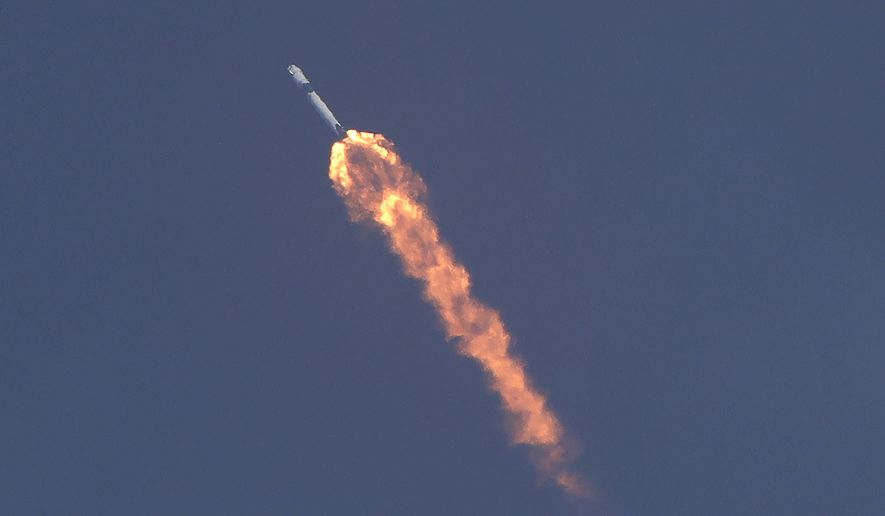U.S. astronauts aboard the SpaceX spacecraft docked with the International Space Station on Sunday, celebrating with smiles and hugs from fellow astronauts nearly 19 hours after a historic launch in Florida.
The Crew Dragon capsule carrying astronauts Bob Behnken and Doug Hurley docked at 10:16 a.m. EDT about 260 miles above the China-Mongolia border.
The pair floated through a hatch and into the welcoming arms of fellow American Chris Cassidy and Russian astronauts aboard the space station.
“We’re just happy to be here, and Chris is going to put us to work. And hopefully we will fit in and not mess too many things up,” Col. Hurley said.
The first manned space mission from U.S. soil in nine years offered a dazzling, the-future-is-here moment amid a deadly COVID-19 pandemic and violent protests in the wake of George Floyd’s death in police custody in Minnesota.
It also represented a new era of space travel, as NASA partners with commercial entities such as Elon Musk’s SpaceX and as President Trump touts his plan to send humans back to the moon and then to Mars. The launch may also set the table for private space tourism for people with the means.
“The whole world saw this mission, and we are so, so proud of everything you’ve done for our country and, in fact, to inspire the world,” NASA Administrator Jim Bridenstine told the astronauts Sunday.
Mr. Trump and Vice President Mike Pence watched from a rooftop 2 miles away Saturday as the Falcon 9 rocket launched the Crew Dragon capsule from the Kennedy Space Center in Florida.
The astronauts gave a thumbs-up before the successful liftoff, and Mr. Trump applauded from his viewing position.
Later, the president reported that the spacecraft had reached low Earth orbit.
“With this launch, the decades of lost years and little action are officially over,” Mr. Trump said at a NASA pep rally. “A new age of American ambition has now begun.”
Mr. Musk, the founder of SpaceX, monitored the mission from the company’s launch control center and celebrated afterward with NASA employees, Mr. Trump and Mr. Pence.
Saturday’s launch was the second try. Poor weather scrubbed Wednesday’s attempt. Mr. Trump traveled to Florida for both.
Mr. Trump said the launch marked the revival of American space ambitions. He said moving forward, NASA will leverage private-sector ingenuity and rebuild the country’s stature in the great beyond.
“You can’t be No. 1 on Earth if you are No. 2 in space,” Mr. Trump said Saturday. “We are not going to be No. 2 anywhere.”
Mr. Pence said the rocket launch could help the U.S. find the “unity of purpose” that the Apollo missions provided in the 1960s.
“In America, every life matters and there’s no tolerance for racism or violence in the streets,” said Mr. Pence, alluding to widespread protests of police brutality. “We will honor the life of George Floyd. We will have law and order in our streets, and we will heal our land. And we will prove again that even in the most challenging times, Americans rise above. We always move forward.”
NASA hasn’t sent astronauts into space from U.S. territory since the Space Shuttle program ended in 2011. It has been forced to rely on Russian launches to get to the space station since then, but the use of Mr. Musk’s venture marked a pivot to the U.S. private sector.
“I would say [the launch] is extremely important for the United States because it marks the first time that we’re going to have commercial launch systems and we’re also going to have a diversity of launch systems,” said Phil Metzger, a planetary scientist at the University of Central Florida who worked at NASA for three decades.
Relying on a single, government-run system has pitfalls. The shuttle program was grounded at the start of the 1990s because of hydrogen leaks.
The launch ended another frustrating gap in U.S. space exploration, partly because of lackluster funding from Congress, Mr. Metzger said.
“It was not supposed to be a nine-year gap. Now we are finally ending the gap,” he said.
Having a diversity of programs, including lunar mining and space tourism, will be critical to meeting U.S. ambitions in space, he added. He foresees people buying tickets to the moon within two decades.
Mr. Bridenstine said last week that Mr. Musk’s company showed the ability to adapt quickly after test accidents on the ground.
“SpaceX can do things that NASA historically has not done,” he said. “They test, they fail, they fix, they fly, until the point where we are today, where not only is SpaceX comfortable, but NASA is comfortable.”
He relished the success of the mission.
“Go NASA. Go SpaceX. Go America,” Mr. Bridenstine told cheering employees at his agency.
Former Vice President Joseph R. Biden, the presumptive Democratic challenger to Mr. Trump in November, took partial credit for the launch. He said the Obama administration’s 2009 stimulus effort bolstered the aerospace sector in Florida.
“I congratulate NASA, SpaceX, and all the hardworking women and men who made today a victory for American innovation and persistence,” he said. “This mission represents the culmination of work begun years ago, and which President Obama and I fought hard to ensure would become a reality.”
• Tom Howell Jr. can be reached at thowell@washingtontimes.com.




Please read our comment policy before commenting.